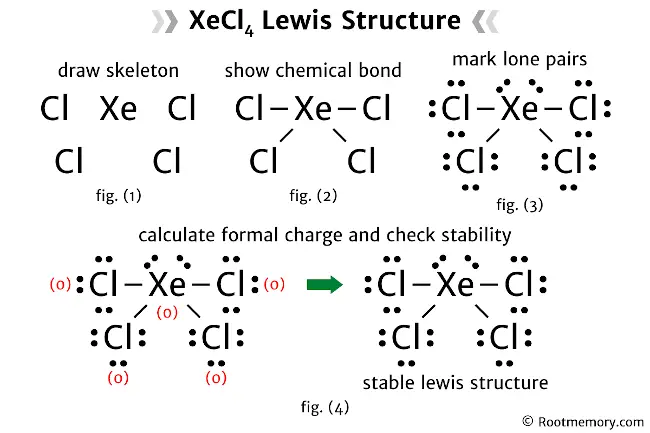
The Lewis structure of XeCl4 illustrates the molecular arrangement of xenon tetrachloride, a compound composed of one xenon and four chlorine atoms. In this structure, the xenon atom occupies the central position and forms single bonds with each of the four chlorine atoms. The xenon atom carries two lone pairs, while each chlorine atom possesses three lone pairs.
For an accurate depiction of the Lewis structure of XeCl4, begin by creating a rough diagram, and illustrate chemical bonds between each atom. If any lone pairs exist in the structure, include them and confirm the satisfaction of the octet rule for both the central atom and the surrounding atoms. In the final step, check the structure’s stability by calculating formal charges for each atom, and aim to achieve a stable Lewis structure with minimal formal charges.
Alternative method: XeCl4 Lewis structure
Steps
Rough sketch
In this step, first calculate the total number of valence electrons. And then, decide the central atom.
- Let’s calculate the total number of valence electrons
We know that… xenon is a group 18 element and chlorine is a group 17 element. Hence, xenon has eight valence electrons and chlorine has seven valence electrons.
Now XeCl4 has one xenon atom and four chlorine atoms.
So the total number of valence electrons = valence electrons of xenon atom + (valence electrons of chlorine atom × 4)
Therefore, the total number of valence electrons = 8 + 28 = 36
- Now decide the central atom
The atom with the least electronegative value is placed at the center. By looking at the periodic table, we get the electronegativity values for xenon and chlorine as follows:
Electronegativity value of xenon = 2.6
Electronegativity value of chlorine = 3.16
Obviously, xenon is less electronegative than chlorine. Hence, assume that xenon is the central atom.
So now, put xenon in the center and chlorines on either side. And draw the rough skeleton structure for the Lewis structure of XeCl4 something like this:

Also read: How to draw CH3+ Lewis structure (3 steps)
Chemical bond
Place two electrons between the atoms to show a chemical bond. Since xenon is surrounded by four chlorines, use eight electrons to show four chemical bonds as follows:

Also read: How to draw Lewis structure of CH3NCO (5 steps)
Lone pair
As calculated earlier, we have a total of 36 valence electrons. And in the above structure, we have already used eight valence electrons. Hence, twenty-eight valence electrons are remaining.
Two valence electrons represent one lone pair. So twenty-eight valence electrons = fourteen lone pairs.
Note that xenon is a period 5 element, so it can keep more than 8 electrons in its last shell. And chlorine is a period 3 element, so it can keep more than 8 electrons in its last shell.
Also, make sure that you start marking these lone pairs on outside atoms first. And then, on the central atom.
The outside atoms are chlorines, so each chlorine will get three lone pairs. And the central atom (xenon) will get two lone pairs.
So the Lewis structure of XeCl4 looks something like this:

In the above structure, you can see that the octet is completed on the central atom (xenon), and also on the outside atoms. Therefore, the octet rule is satisfied.
After completing the octet, one last thing we need to do is, calculate the formal charge and check the stability of the above structure.
Also read: How to draw Lewis structure of CO2 (5 steps)
Formal charge and stability
The following formula is used to calculate the formal charges on atoms:
Formal charge = valence electrons – nonbonding electrons – ½ bonding electrons
Collect the data from the above structure and then, write it down below as follows:
- For xenon atom
Valence electrons = 8
Nonbonding electrons = 4
Bonding electrons = 8
Formal charge = 8 – 4 – ½ (8) = 0
- For each chlorine atom
Valence electrons = 7
Nonbonding electrons = 6
Bonding electrons = 2
Formal charge = 7 – 6 – ½ (2) = 0
Mention the formal charges of atoms on the structure. So the Lewis structure of XeCl4 looks something like this:

In the above structure, you can see that the formal charges of both (xenon and chlorine) are zero. Therefore, this is the stable Lewis structure of XeCl4.
And each horizontal line drawn in the above structure represents a pair of bonding valence electrons.
Next: CH3+ Lewis structure
Related
- CH3+ Lewis structure
- Lewis structure of CH3NCO
- Lewis structure of CO2
- Lewis structure of H2O
- Lewis structure of NO2
External video
- XeCl4 Lewis Structure: How to Draw the Lewis Structure for XeCl4 (Xenon Tetrachloride) – YouTube • Wayne Breslyn
External links
- XeCl4 Lewis Structure, Geometry, Hybridization, and Polarity – Techiescientist
- Drawing the Lewis Structure for XeCl4 – The Geoexchange
- XeCl4 Lewis Structure in 5 Steps (With Images) – Pediabay
- Draw the Lewis structure for XeCl4 – Homework.Study.com
- Draw the Lewis structure of XeCl4 showing all lone pairs – Chegg
- How to draw XeCl4 Lewis Structure? – Science Education and Tutorials
- Draw the lewis structure of xecl4 showing all lone pairs – Brainly
- What is the electron geometry of XeCl4? – Quora
- Draw the Lewis structure of XeCl4 showing all lone pairs – OneClass
Deep
Rootmemory.com was founded by Deep Rana, who is a mechanical engineer by profession and a blogger by passion. He has a good conceptual knowledge on different educational topics and he provides the same on this website. He loves to learn something new everyday and believes that the best utilization of free time is developing a new skill.
